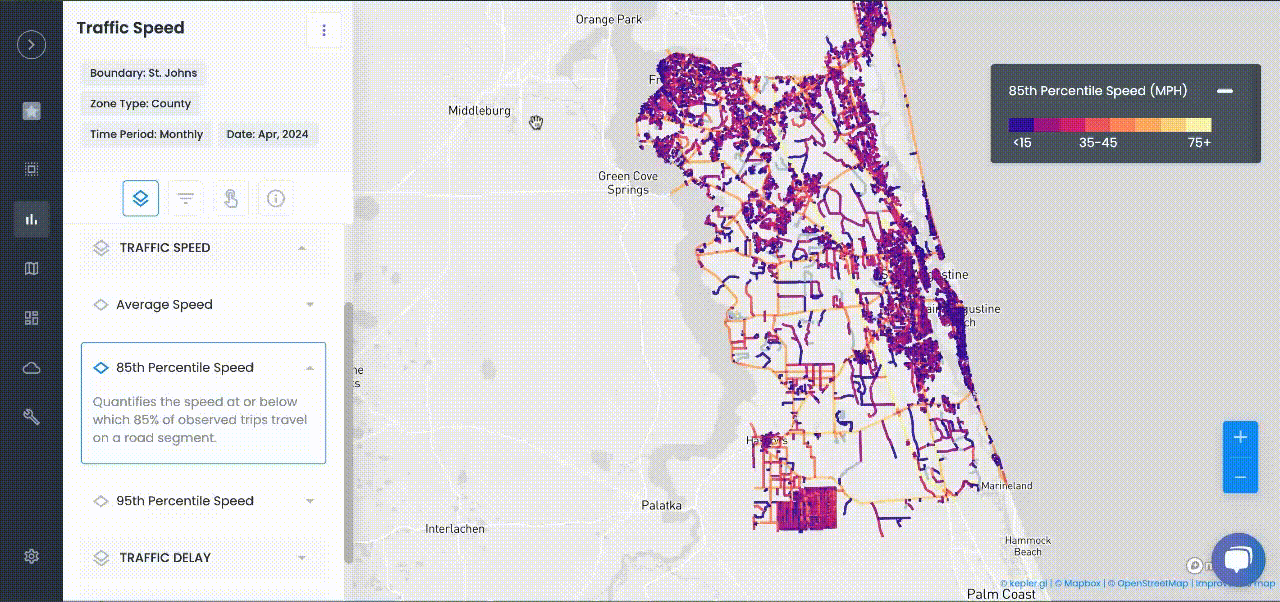
Road Safety
6 Powerful Ways AI is Transforming Transportation Safety and Efficiency
AI is already transforming transportation across the country in powerful ways.
AI is already transforming transportation across the country in powerful ways.
As cities grow more complex and mobility needs evolve, public agencies face increasing pressure to reduce traffic-related injuries and fatalities — while simultaneously improving efficiency, meeting climate goals, and justifying infrastructure investments.
For decades, transportation planning relied on historical crash reports, manual analysis, and static infrastructure. But the pace and complexity of today’s mobility challenges demand smarter tools — and Artificial Intelligence (AI) is stepping in to meet that need.
At Urban SDK, we view AI not as a buzzword — but as a practical, scalable solution for public leaders who need to make data-informed decisions every day. From predictive safety insights to automated reporting, AI is helping agencies reduce risk, operate more efficiently, and plan for a safer, smarter future.
Let’s take a closer look at six powerful ways AI is already transforming transportation across the country.
1. AI for Predictive Safety and Crash Prevention
AI allows agencies to go beyond what’s happened — and start planning for what’s likely to happen next.
By analyzing a combination of real-time and historical data (such as crash records, speed trends, and vehicle volumes), AI models can predict high-risk zones before incidents occur. This enables cities to:
- Identify emerging problem areas
- Prioritize safety interventions based on projected risk
- Justify funding for targeted infrastructure improvements
This type of forecasting is critical for Vision Zero and SS4A strategies, where cities are expected to take proactive steps toward reducing serious injuries and fatalities.
We help cities use AI-powered analytics to visualize risk on maps, compare performance over time, and make smarter infrastructure investments with confidence.
2. Computer Vision for Behavior-Based Road Monitoring
Traditional traffic safety strategies often miss the near-misses. AI-powered computer vision systems fill in the gaps.
These systems analyze footage from traffic cameras to detect:
- Red-light running
- Wrong-way driving
- Hard braking and unsafe lane changes
- Pedestrian-cyclist-vehicle conflicts
What makes this powerful is that it focuses on driver and pedestrian behavior, not just crash outcomes. For example, frequent red-light running at an intersection may indicate the need for signal timing adjustments, signage updates, or traffic calming — even before a crash happens.
Cities using this technology gain deeper visibility into how road users interact with infrastructure — and where safety improvements are most urgently needed.
3. AI-Powered Traffic Signal Optimization
Poor signal timing doesn’t just frustrate drivers — it can create congestion, increase emissions, and lead to dangerous driving decisions.
AI-powered signal optimization systems use data from connected vehicles, sensors, and real-time traffic patterns to adjust signal timing dynamically. These systems can:
- Prioritize heavily trafficked corridors
- Allow emergency vehicles to pass more efficiently
- Reduce idling and fuel consumption
- Minimize pedestrian wait times
This leads to smoother, safer traffic flow — particularly in dense urban areas where timing inefficiencies can cascade into city-wide slowdowns.
At Urban SDK, we help public agencies use AI to evaluate current signal performance and simulate the impact of optimizations before physically implementing changes.
4. Smart Infrastructure and Sensor Fusion
Infrastructure is no longer just concrete and metal — it’s connected, data-rich, and increasingly intelligent.
Using IoT-enabled sensors, cameras, and radar, cities can gather information from roads, intersections, and sidewalks. AI helps fuse this data into actionable insights by detecting:
- Hazardous driving conditions (e.g., wet pavement, poor visibility)
- Stalled vehicles or obstructions
- Structural wear in bridges or barriers
- Pedestrian movement near high-risk crosswalks
These insights power real-time interventions — like dynamic speed limits, flashing pedestrian warnings, or maintenance alerts — that improve road safety without increasing staff workload.
Urban SDK’s platform integrates this sensor data into a single performance view, helping agencies track both safety outcomes and infrastructure health simultaneously.
5. AI in Public Transportation Planning
Public transportation systems thrive on accuracy, reliability, and resource efficiency — all areas where AI excels.
By analyzing ridership patterns, vehicle telemetry, traffic congestion, and demographic trends, AI can help cities:
- Forecast peak demand periods
- Optimize bus routes and stop placement
- Adjust headways to meet rider needs
- Improve on-time performance and reduce operational costs
This makes it easier to align transit with broader goals around accessibility, sustainability, and equity — especially as cities seek to reduce car dependency and expand multimodal networks.
We work with agencies to incorporate AI-generated transit insights into city-wide planning efforts — enabling smarter transit development tied to real mobility patterns.
6. Automated Performance Monitoring and Grant Reporting
Managing performance metrics, compliance data, and grant reporting can be a heavy lift — especially for smaller agencies.
AI helps by automating much of the data collection and analysis, including:
- Corridor-level safety performance
- Speed compliance trends
- Before-and-after impact reports
- Custom dashboards for stakeholder updates
This not only saves time and staff resources — it creates consistent, transparent reporting that strengthens grant applications and supports long-term accountability.
Urban SDK’s performance tools are designed to align with federal frameworks like SS4A, FAST Act, and Vision Zero — so cities can move from manual reports to live dashboards with just a few clicks.
So, In conclusion, Artificial Intelligence is reshaping transportation — not just in theory, but in real-world public sector workflows. It’s not about replacing planners, engineers, or public works teams — it’s about giving them smarter, faster tools to achieve their goals.
Whether you're trying to:
- Reduce crashes
- Optimize infrastructure
- Justify new funding
- Or modernize outdated systems
AI gives you the insights to act confidently — and measure impact with precision.
At Urban SDK, we’re committed to helping agencies adopt practical, purpose-built AI solutions that are easy to use, customizable for local needs, and focused on results.
Because the future of road safety and mobility isn’t just digital — it’s human-centered, data-driven, and built to scale.

TRAFFIC ENFORCEMENT FEATURES
80% of citizen complaints
are a perception problem
Urban SDK provides precise hourly speed data to evaluate complaints and deploy resources efficiently for the greatest impact to public safety.
Urban SDK provides precise hourly speed data to evaluate complaints and deploy resources efficiently for the greatest impact to public safety.
Target Speeding
Identify hot spots, validate monthly speeding trends and monitor vulnerable areas like school zones.
Improve Safety
Crash and citations location information to compare speed trends month over month
Fast Response
Respond to citizen complaints sooner with address search and exportable reporting
Deploy Assets
Generate maps for traffic enforcement by time of day, location or division to deploy officers to known problem areas.
RESOURCES
Customer Success
See how public sector leaders succeed with Urban SDK.
WEBINAR
Identify speeding and proactively enforce issues
See just how quick and easy it is to identify speeding, address complaints, and deploy officers.







